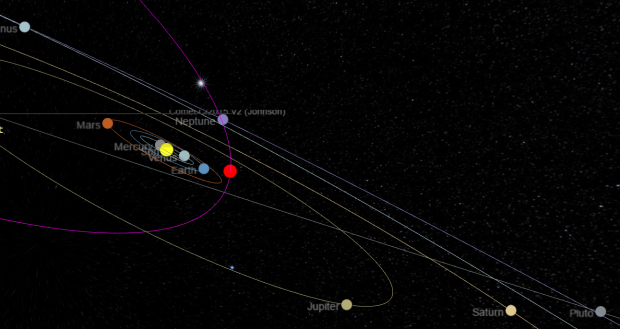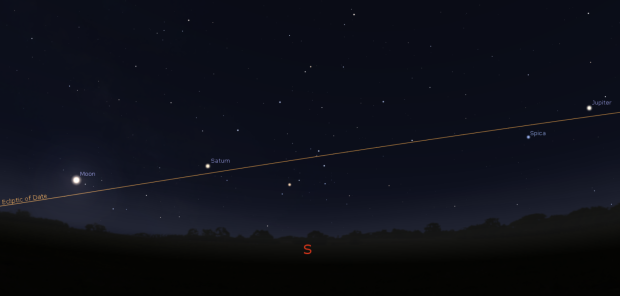
Starting out three years ago I inevitably began my astrophotography with the Solar System, the planets and other related bodies are after all closest to Earth but, as it turns out, are far from easy to image. At the time using a Skywatcher 150PLS and ZWO120MC webcam, I achieved some reasonable images of Saturn, Jupiter, Mars, the Moon and later the Sun but with plenty of upside potential for improvement! Shortly thereafter having acquired my current set-up, I realised that my interest lay in DSO targets and, except for the lunar eclipse in 2015 and the odd white-light image of the Sun, have mostly ignored the Solar System, until now. Currently no less than 7 planets are present throughout the night at the moment, the largest of which provide good viewing and imaging opportunities – planetary sky above for 11th June 2017 at 11 p.m. taken from TheSkyLive.com
From April to July there are limited DSO opportunities for my scope and camera and the only choice is to look elsewhere; the absence of astronomical darkness also doesn’t help. This year the problem has been particularly frustrating as I’m itching to get to grips with my new ZWO 1600MM-Cool camera, which after a few hurried shots early in the year proved very exciting. And so I’ve recently been playing around, returning to old subjects and unfamiliar equipment – first imaging the comet C/2015 V2 (Johnson) and again trying my hand again at some of the planets.
Unlike the DSLR and ZWO 1600MM-Cool CMOS camera, I the ZWO 120MC video based webcam is more suitable for the planets, which poses a whole new set of issues and the use of completely different capture and process software, in my case Firecapture for imaging and Registax for processing. Both are excellent free programmes but after three years required some re-learning.
Firecapture helps a lot when experimenting to find the best gain, gamma and exposure settings for each planet but there are still other difficult tasks to overcome, in particular planetary rotation, size, seeing conditions and my personal nemesis – focus – which after numerous attempts I have still failed to master. The truth is that even with the gas giant Jupiter, the planet appears quite small with the 81mm aperture of my Williams Optics refractor and detail is difficult to make out in order to focus when also blurred by atmospheric turbulence. Notwithstanding, the belts and even the Great Red Spot are evident in the resulting images taken between 14th and 25th June, albeit a little fuzzy!
Webcam image data capture even over a couple of minutes is prodigious and requires significant processing capacity to handle. I have found the aptly named Castrator software useful in this regard to cut the final AVI image down to the actual size of the planetary object, thus removing substantial areas of superfluous black sky. Registax is equally powerful for video processing and stacking, in particular the intriguingly named Wavelets, which magically help restore detail and sharpness.

In the case of Saturn, which at the moment is quite bright and well orientated, the problem is also size and especially seeing, in my case not helped by a 35 minute imaging window as the planet transits between two trees at the end of my garden; at least the large copper beech on the left blocked out the Moon at the same time! At this location Saturn is less than 15o above the southerly horizon and as a result seeing conditions are at best poor and usually bad. However, I manged some blurred images that clearly show Saturn’s rings and even a little colour. I’m now looking forwards to seeing more of the final Cassini mission images before the satellite crashes into the plant in September.
These are obviously not my best images and I already feel the need try again next year, hopefully with a more appropriate telescope (Santa has already been informed). Notwithstanding, my return to the Solar System has been fun and, in between imaging I’ve also taken time to carry out observational astronomy – something I rarely do nowadays being otherwise consumed by astroimaging paraphernalia. DSO astrophotography is likely to remain my main interest in the future and I can’t wait to revisit old favourites later in the year with the new ZWO 1600MM-Cool camera. In the meantime, I have renewed respect for the planetary astrophotographer’s, I’ll be back another time.






